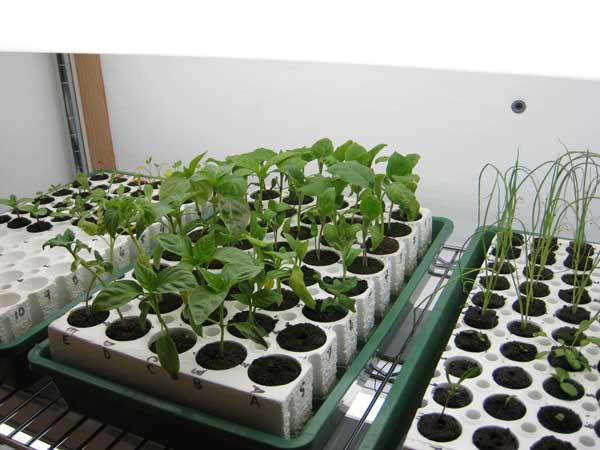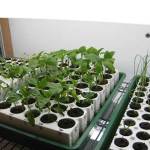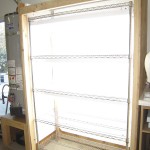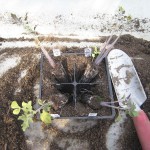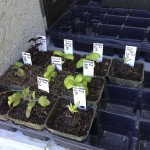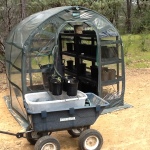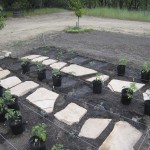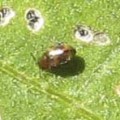Starting vegetables by seed can be more rewarding and more economical for most people; however, the time investment (and sometimes emotional investment) is huge. These guidelines will work for starting most vegetable and flower seeds, although I wrote them with the nightshade family (except potatoes) in mind. See individual growing articles for more in-depth info on propagation: Eggplant, Peppers, Tomatoes. Also, gel-sowing seeds is a good alternative method.
1. Calculate how many plants to start:
I start double the number of seeds that I will need, if there are no space or money constraints. If there are, then I start about 1.5 times what I want out in the garden. This allows for problems in the starting process. I’ve almost always had perfect germination rates, so I usually have too many for the garden.
2. Calculate when to start:
Eggplants should be started 8 to 10 weeks before the last frost date. Peppers and Tomatoes should be started 6 to 9 weeks before the last frost date in your area. In Redding, Northern California, I live in zone 9, I start them in mid-February.
If you start them too early, you may find the plants less productive if you plant them out when it’s still too cool outside. Then, if you wait for it to warm up enough, you will have to transplant them too many times before planting out. It’s just more work.
3. Pick your containers:
For most vegetables, using cell packs or other individual planting units for each plant produces the highest quality seedling.
- there’s no competition so the seedling forms a healthy rootball
- they transplant well since there’s hardly any disturbance to the rootball
Many sizes of cell packs are sold, all to fit a standard tray (known as a 1020 tray) that catches drainage and makes it easier to move the cell packs around.
4. Pick your growing medium:
For growing medium, a soil-less medium is best, and the coolest thing I’ve found is block or sponge that slips right into the cell. They are made in many different sizes. Trade names are Bio Sponge or Perfect Starts. These go well with floating seed starting trays made out of styrofoam. Ever since switching to these, I have outstanding germination rates – even with very old seeds.
5. Sow the seeds:
- Sow 2 or 3 seeds per cell, to their required depth
- For tomatoes, choose “the most plump, regular-shaped, and hairy seeds (commercial ones are often defuzzed) and reject the weirdos”, says Amy Goldman (author of “The Heirloom Tomato: from Garden to Table”)
- Water very gently, so as to not wash them away; don’t let the soil ever dry out, but don’t water-log them
6. Temperature:
For nightshades, like bell peppers & tomatoes, eggplants and chile peppers, try to keep the seed-starting medium at least in the 70’s for good germination; 90°F is ideal
7. Light:
- Darkness is best until they have peaked above the soil, but then a sunny window-sill or fluorescent lighting will give the seeds enough light for the early stages
- Remember to turn the seedlings regularly to so they don’t stretch in one direction
8. Ventilation:
Good ventilation is tricky, when you are trying to keep the temperature up & the seedbed moist, but it’s a must. Poor ventilation will encourage fungus or mold and the dreaded damping off disease. This is where a strong seedling all of a sudden falls to the bed. It looks like something squeezed it’s stem at the base and throttled it. This means there wasn’t enough ventilation or it was too wet.
9. Cultivation:
Once your seeds have germinated and are putting out their true leaves, clip the weaker starts to leave the strongest start in each cell.
Also, keep turning your tray to all 4 directions to make strong stems, and equal growth. Strong stems can also be cultivated by sweeping your hand back and forth over the seedlings, bending them a bit.
10. Transplanting or Potting Up:
- First round of transplanting (up-potting) for these tomato seedlings
- Seedlings after first round of transplanting.
- Various starts waiting to be planted
Once the seedlings have 2 to 4 true leaves, it’s time to transplant them into a 3-4 inch cell or pot. You can buy inserts for your 1020 tray in these sizes, which are easy to transplant into and out of. At this point they need to have cooler temperatures (60-70°F) and full-spectrum sunlight to prevent legginess, per Territorial Seed Co
Water only when the surface dries out, and fertilize with fish emulsion ever 10-14 days.
They can remain in these for another 8 to 10 weeks, but if it’s still not warm enough outside, transplant them again into a larger pot. I consider it to be warm enough when it gets to 45-55 degrees at night for the tomatoes, but eggplants are a bit more picky. Don’t set eggplants out until the soil temperatures are 55-60°F (about 2-4 weeks after last frost date).
11. Planting Out
When the risk of frost is over and it’s warm enough at night (45-55 degrees) it’s time to start hardening off the seedlings. Place the seedlings outdoors for increasing lengths of time, in a sheltered spot. Eventually, leave them out overnight, against a wall.

